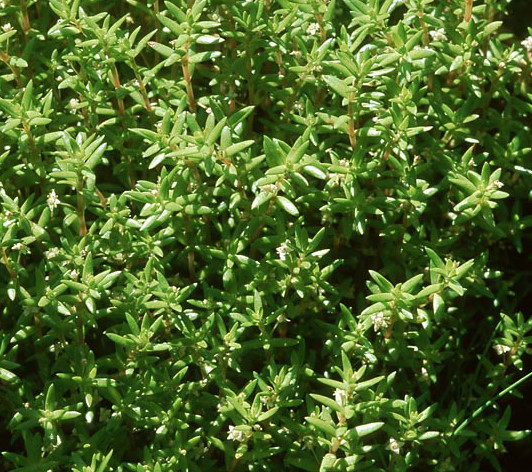| There are two articles on this page: | |
| A brief article profiling Crassula helmsii. | |
|
|
A list by State of prohibited aquatic plants for Australia. |
| There are two articles on this page: | |
| A brief article profiling Crassula helmsii. | |
|
|
A list by State of prohibited aquatic plants for Australia. |
An Australian Invader Of Europe- now that's a twist on history!
| Crassula helmsii, a native of Australia and New
Zealand, is known commonly as Pygmyweed, New Zealand
Stonecrop, Australian Swamp Stonecrop, Pygmy Weed or, as my folks
called it, "the Oxygen Plant". In its natural habitats it grows at
the edge of billabongs, swamps, ponds, bogs and streams and is
hardy. It is found along the River Murray (when the river was
more pristine than it is now!), as a marginal plant to
streams, billabongs and ponds, where it forms dense, domed mats.
It is a fast-growing plant that forms tight hummocks of fine
succulent, bright green foliage. The white blossoms are tiny
and insignificant. As an introduced plant in Britain, Europe and the USA, it has become an invasive, pest species, spreading rapidly and choking shallow waterways. When used in ponds and ornamental water features, Crassula helmsii is an attractive plant, with tight mounds of bright foliage, growing 5-10cm in height. It can also be grown very successfully as a totally submerged plant. It likes full sun and is frost-hardy. Propagation is easy from bunched cuttings or by division. C. helmsii can reproduce vegetatively from small fragments of shoot (5-10 mm) that contain a node. Stem fragments can be broken away from mature plants and float around water ways before settling and growing. In addition, asexual reproduction is achieved via the production, in autumn, of short shoots with very short internodes, known as turions. These are produced at the tips, and float or are blown around the water surface, but have not been observed to sink. Turions appear to be very effective at colonising new areas when they lodge in detritus at the water's edge. |
 Crassula helmsii (Cockayne, 1907, et al) Pygmyweed, Swamp Stonecrop
A weed is any plant growing in the wrong habitat. Crassula helmsii in Britain was most likely introduced by deliberate, human action, as were Oxalis pes-caprae and Echium plantagineum - pests introduced into South Australia. Now we know the risks, let us all be careful. |
|
|
If you acquire Crassula, please do not put it into dams and waterways but keep it securely inside your tank. A RUINOUS LEGACY Of course, Britain, Europe and the USA are not alone in having weeds introduced to their environments. It is one of the unfortunate consequences of European and Asian settlement in Australia (and other places) that numerous weed species were introduced to Australia from Britain, Europe, Africa, Asia and the Americas. Canary Island Date Palms, pines, European ash trees, willows, olives, thistles, convolvulus, dandelions, Sour Sob (Oxalis pes-caprae) and Salvation Jane (a.k.a. Paterson's Curse, Echium plantagineum) are common plant pests in South Australia. All were introduced by deliberate, human activity and have replaced most of the endemic species as dominant features of the landscape. Plants were not the only things to go feral, in South Australia (and I don't mean Bushrangers) for animal and bird species introduced from Britain have ruined much of the landscape, too. Rabbits, foxes, rats, mice, cats, blackbirds, sparrows, starlings and European Carp have replaced native fauna to a very significant degree in many places. In the case of olives and C.I. Date Palms, the agents in spreading the infestations are introduced, European birds! There are also insect pests, including the European Wasp, millipedes from Portugal, ants from Argentina, cockroaches from North America and Cane toads from South America. The toads were introduced in an attempt to control an introduced, insect pests but they became a greater pest themselves. Early settlers from Europe and Great Britain were eager to make their new lands just like the familiar sights of Britain. In many places, the land was rendered unusable in less than a generation through clearing, farming of marginal lands and the impact of plagues of rabbits. They were not careful in protecting the biodiversity of Australia and have left us a ruinous legacy of weeds and feral animals and birds. Their descendants need to do much better in preserving the remnants of Australia's unique, flora and fauna. Aquarium keepers need to be vigilant so that introduced species do not become pests. The marine alga, Caulerpa, has become a pest in the Port River system, notably at West Lakes, South Australia, where a variety of Caulerpa used in marine aquaria has been introduced, most probably by human action. It is growing prolifically and is proving difficult to eradicate. Including Caulerpa, 10 aquatic plants are banned from use or importation and culture into South Australia. They are all fresh water species and are listed below.
Our water ways are also at risk from foreign plants so please do not introduce foreign species to our environment. I have listed below, the prohibited aquatic plants in Australia so that aquarists who read this may be careful about their plant selections for their tanks.
|
||
|
GOOD LUCK WITH YOUR FISHKEEPING |